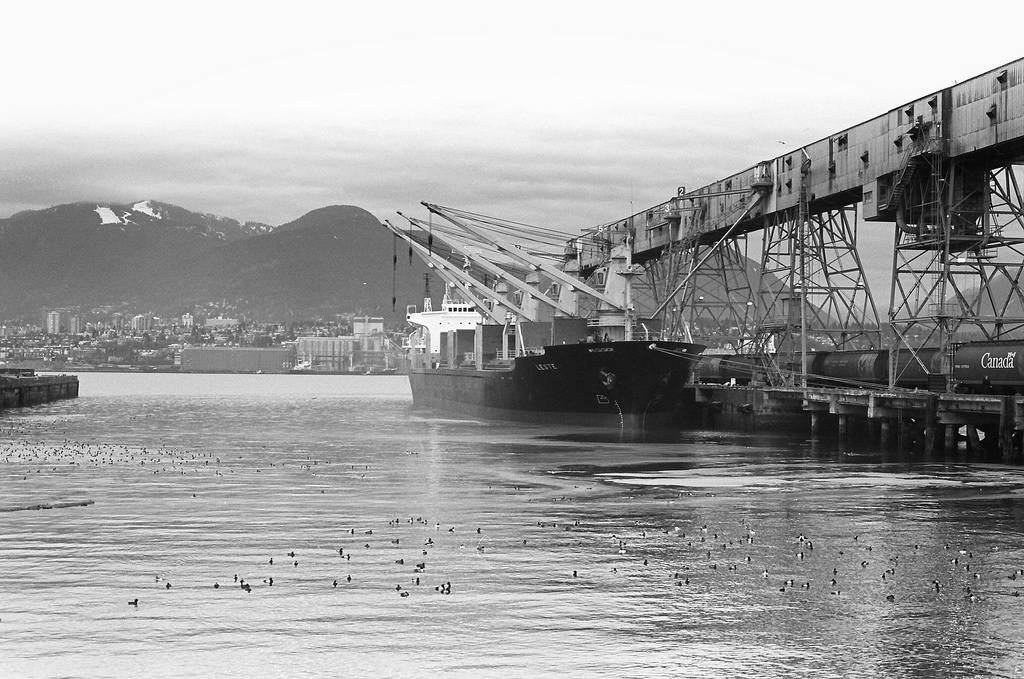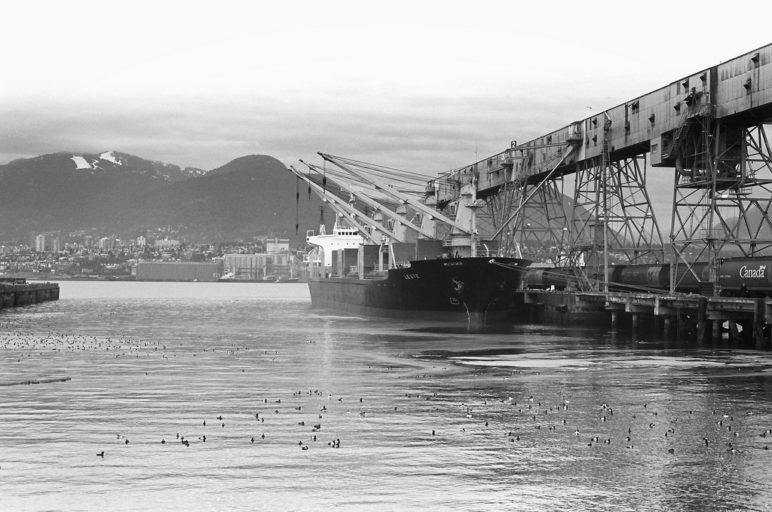Every week another barge or tanker traverses the narrow straits through the San Juan Islands north of Seattle, bearing a cargo of tar-sands crude or other heavy oils from Canada, headed for refineries in Washington and California. But the Kinder Morgan Trans Mountain Pipeline Expansion Project approved in late 2016 by the government of Canadian Prime Minister Justin Trudeau threatens to make such transits daily occurrences, thus increasing many-fold the chances of a major oil spill in the Salish Sea and other Pacific Northwest waters.
The $7.4 billion Kinder Morgan project would add another pipeline alongside one that already extends from Edmonton, Alberta, to the Westridge Terminal in Burnaby, near Vancouver, British Columbia. It would increase the system’s capacity from 300,000 to 890,000 barrels per day. Most of the additional oil would be tar-sands crude that would be loaded onto another 348 tankers plying the Salish Sea every year.

The San Juan Islands archipelago, as viewed from the south, with San Juan and Lopez Islands in the foreground. By H. Gary Greene, SeaDoc Society and Tahoe Images, used with permission.
In order to flow through pipelines, the viscous, tarry bitumen mined in Alberta must be diluted with light hydrocarbons like benzene or naphtha—and is thus called diluted bitumen, or “dilbit” for short. If the dilbit were to be spilled from a tanker into the Northwest’s inland sea, a portion of it might be corralled and removed by prompt action of the Canadian or US Coast Guard and other responders.
But not all of it. According to an authoritative 2015 report from the US National Academies of Sciences and Engineering, a significant fraction would likely sink to the sea floor and remain unrecoverable for decades, if not centuries, harming Dungeness crab, rockfish, sand lance, and other bottom-dwellers. It would also seriously threaten migrating salmon and the totemic, endangered Southern resident killer whales, which ultimately depend on these members of the marine food chain, especially Chinook salmon. A major dilbit spill in the Salish Sea could easily trigger an ecological catastrophe.
Something similar occurred in 2012 near Marshall, Michigan, when an Enbridge pipeline ruptured, releasing nearly a million gallons of dilbit into a tributary of the Kalamazoo River. A large portion sank, evading recovery efforts designed for floating oils, and contaminated 25 miles of river bottom. Enbridge spent over five years and $1.2 billion trying to remove the sticky residues, but a significant fraction still remains. And that spill happened in a shallow riverbed, not the deep, fast-flowing channels around the San Juan Islands.

Results of computer simulations showing how a major oil spill at the BC Ferry crossing would have spread in the summer of 2012. Adapted by Shaun Hubbard from Kinder Morgan report, used with permission.
This tar-sands threat is not confined to the Salish Sea. Many of the tankers carrying oil from an expanded Kinder Morgan pipeline would head south along the US West Coast and offload their gooey cargoes in California, where refineries are able to handle heavy oils. (More dilbit-laden barges would also pass through Puget Sound to a Tacoma refinery.) And dilbit could be shipped through Pacific Northwest waters by other routes, too. For example, the proposed Tesoro oil terminal on the Columbia River at Vancouver, Washington, could load up to a barge or tanker per day with dilbit headed for these refineries. Laden with oil, the ponderous vessels would then have to clear the treacherous Columbia Bar at the river mouth.
The eastern seaboard is not immune from the tar-sands threat either. The Energy East pipeline proposed by TransCanada Corporation would bring up to 1.1 million barrels of dilbit daily from Alberta to New Brunswick, loading a procession of nearly 300 gargantuan tankers per year that would lumber down the East Coast and around Florida to Gulf Coast refineries. Even the Hudson River might become a tar-sands oil highway, if planned modifications to a crude-by-rail terminal at Albany are permitted, allowing the oil to be off-loaded from railcars onto barges for shipment to New Jersey and Delaware refineries.
The behavior and fate of tar-sands oil spills
When dilbit enters water, it separates into its primary components—the original tar-like bitumen and volatile components such as benzene, which rapidly evaporates. This noxious gas, a carcinogen, makes dilbit spill recovery extremely difficult for early responders, who would require artificial breathing apparatuses to work near the spill, the National Academies study concluded.
What happens in the next day or two following a spill likely depends on circumstances. Most research shows that part of the bitumen released will sink, as happened in the Kalamazoo River, especially when wind or waves and fine sediments are present. This is usually the case in spring and summer near the San Juan Islands, when strong Fraser River outflows carry millions of tons of sediment into the Salish Sea. A major spill in these waters would likely result in many tons of sinking dilbit that could never be removed.

Ship-level view of the Fraser River plume in southern Georgia Strait, showing fine sediments in the otherwise blue-green waters. By Ocean Networks Canada, used under CC BY-NC-SA 2.0.
The lengthy report prepared for Canada’s National Energy Board on the Kinder Morgan project completely ignored this possibility, however. It claimed that any spilled tar-sands oil could be cleaned up by conventional methods like booming, burning and skimming—but those methods only work if the oil remains on the surface. The report’s authors based this conclusion on tests (called the Gainford study) that attempted to simulate conditions in Burrard Inlet north of Burnaby, where strong winds and sediments are encountered only rarely. They then applied the results of these narrowly limited tests, which showed only small amounts of sinking oil, to all portions of the Salish Sea where the tankers would travel.
A major spill in these waters would likely result in many tons of sinking dilbit that could never be removed.
But the much more authoritative National Academies report concluded that “spills of diluted bitumen pose particular challenges when they reach water bodies. In some cases, the residues can submerge or sink to the bottom.” It also stated that dilbit spills are “highly problematic for spill response because there are few effective techniques for detection, containment, and recovery” of sinking oils. Asked about dilbit recovery by Washington Senator Maria Cantwell during a Congressional hearing, US Coast Guard Commandant Admiral Paul Zukunft candidly admitted that “once it settles to the sea floor, our technology is lacking.”
During the prior Canadian federal government under Stephen Harper, National Energy Board officials ignored the National Academies report when they reviewed the Kinder Morgan project, claiming that it had been published too late and would thus be “prejudicial” if considered. This was irresponsible. Prime Minister Trudeau might have corrected the oversight, but he instead compounded the error, ignoring what is obviously the best available science on the behavior of diluted bitumen in marine environments.
Canada’s own federal agencies had in fact reached similar conclusions in an earlier, 2013 report: that dilbit can and will sink in seawater, especially if fine sediments and wind or waves are present. Wind and waves mix the bitumen remaining after evaporation with sediments, and the resulting combination will sink if it’s denser than seawater. Other conditions can lead to sticky, floating masses and tarballs. But the energy board examiners must have ignored this official Canadian report, which was clearly available well before they began deliberations.
Kinder Morgan project based on sham science
Thus, contrary to what Prime Minister Trudeau has publicly stated, the proposed Kinder Morgan project is not based on sound science at all. It’s based on sham science. The Kinder Morgan proposal assumed that dilbit spilled from a tanker would all float and therefore be completely recoverable. It treated such an event as an ordinary oil spill, which it’s not.
Resistance continues to strengthen and grow, likely portending the birth in British Columbia of what some have dubbed “Standing Rock North.”
In truth, Canada does not have the widely claimed “world-class spill recovery system” capable of dealing with dilbit spills. Nobody does. Nor will any nation have such a system until these kinds of spills are better understood and new techniques developed to remove submerged oil from marine waters.
Here in the Salish Sea, San Juan Islanders and their counterparts in Canada’s Gulf Islands worry that distant national governments do not have the wisdom and foresight needed to recognize the Faustian bargain offered by the tar-sands crude industry. We cannot afford another dilbit disaster like the Kalamazoo spill—especially not in the rough, fast-flowing waters around these islands.
As Canada and the United States are unlikely to impose a much-needed moratorium on marine transport of diluted bitumen, the people of the Pacific Northwest are beginning to take matters into their own hands. Ecojustice has filed a lawsuit against Kinder Morgan in Canadian courts, focusing on the likely impacts of the tankers on endangered killer whales. First Nations and Native American tribes are uniting against it. And the city governments of Burnaby and Vancouver are staunchly opposed, too.
Resistance continues to strengthen and grow, likely portending the birth in British Columbia of what some have dubbed “Standing Rock North.”
Sightline Fellow Michael Riordan, a physicist and co-author of The Solar Home Book, Crystal Fire, and Tunnel Visions, writes about science, technology and public policy from his home in Eastsound, Washington.












Earl Richards
The toxic, tar sands have to be refined/upgraded into synthetic crude before transporting from the tar sands regions to prevent another Kalamazoo River disaster, to create Canadian jobs for Canadians and to increase economic development. To understand the destructiveness of a tar sands spill, Google and read, “Michigan oil spill effects could be repeated here,” by Michelle Barlond-Smith. Let’s keep beautiful BC and beautiful WA.
Blair
Here is a simple question, how does the behaviour of dilbit in water differ from the behaviour of the replacement heavy oil that would need to be imported to address the needs of the Puget Sound refineries?
The sediment load from the Fraser will have the exact same effect on heavy crude as it does on dilbit, although the research actually suggests that the dilbit is somewhat more resistant to the effects of sediment load sinking than other heavy crudes. As long as the refineries remain in the Puget Sound they will need source materials so which crude are you suggesting should be used and how should it be transported to the Sound?
Michael Riordan
I have seen no research on the effect of sediment load on the sinking of heavy crude oils, and very much doubt that it will have “the exact same effect . . . as it does on dilbit.” From what I have seen, mainly the Canadian report cited in the text, diluted bitumen has an extra affinity for fine sediments due in part to the fact that the bitumen was originally extracted from tar sands. That’s its natural state, to which it has a strong tendency to return. The same cannot be said for heavy crude oil.